The Komodo dragon (Varanus komodoensis) is classified as endangered on International Union for Conservation of Nature’s (IUCN) Red List, with 1,383 mature individuals remaining in the wild.
What is being done to save the species? What do trends say about the future of the Komodo dragon? How are we learning more about the world’s largest living lizard? Let’s explore the answers together.
Discovering a Dragon
In the early 20th century, rumors circulated about a dragon that lived on the Lesser Sunda Islands in the Indonesian archipelago. Stories of this beast seemed too fantastic to be believed until 1910, when the huge reptile was documented for the first time.
A lieutenant named Jacques Karel Henri van Steyn van Hensbroek was in eastern Indonesia as part of the occupying Dutch colonial force. While stationed on Flores Island, he heard stories of this dragon, or “land crocodile,” as some described it. It had reportedly been sighted on Komodo Island, very near his post on Flores Island. The lieutenant decided to check it out for himself.
Steyn van Hensbroek returned from this expedition with much more than a fantastic story of a mythical beast. He came back armed with a photograph and the skin of the animal. He sent the skin to Major Peter Ouwens, who was the director of a zoo at what is now Bogor, Java. Ouwens hired a hunter who brought back four more specimens. The zoo director introduced the Komodo dragon to the Western world in a 1912 publication.
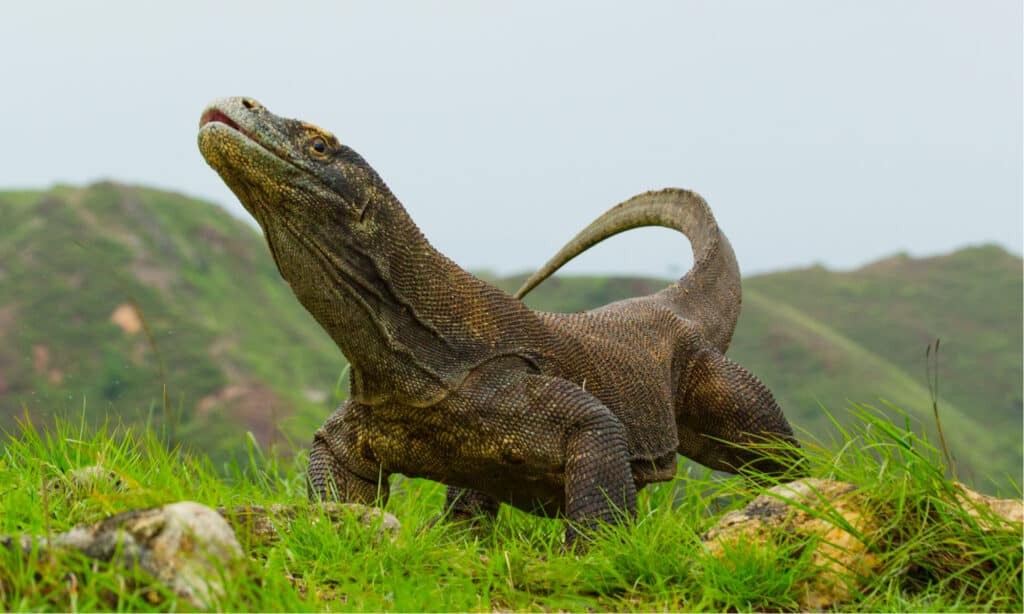
The rumors Steyn van Hensbroek had heard about dragons roaming Komodo Island were true!
©GUDKOV ANDREY/Shutterstock.com
Where Do Komodo Dragons Live Today?
Since that initial discovery, Komodo dragons have been documented on six islands within the Republic of Indonesia: Komodo, Padar, Rinca, Gili Motang, Gili Dasami, and Flores. The reptile has been completely extirpated from one of these islands. No Komodo dragons have been seen on the island of Padar since the 1970s due to the poaching of Timor deer, the dragon’s primary food source. The dragons are also under serious threat on Flores Island.
As this map demonstrates, only a fraction of the Komodo dragon’s small original habitat still has a population of these lizards. Flores Island, by far the largest in the dragon’s native range, is home to nearly two million people. Habitat loss through development and agriculture has decimated the lizard population on the island.
Along with human development, the frequent burning of grasslands to hunt Timor deer has had a devastating effect on the dragon population. These reptiles have also been actively hunted themselves. In the past, farmers would seek out and kill Komodos because of the threat they posed to livestock. Today, the Komodo dragon population on Flores Island is confined to a few small nature preserves.
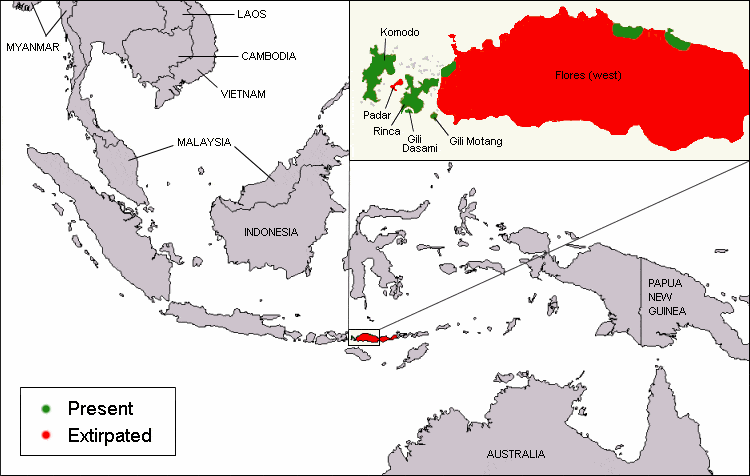
This map shows the historic and current range of the Komodo dragon.
©Tommyknocker at en.wikipedia / Public domain – License
Komodo National Park
The remaining four islands with Komodo dragon populations are now covered by Komodo National Park. The park was established in 1980 to protect these monitor lizards from extinction. The United Nations Educational, Scientific and Cultural Organization recognized the park as a World Heritage Site in 1986.
Thanks to the creation of this protected space, the Komodo dragon population has stabilized. Along with the 1,383 mature individuals documented by IUCN, more than 3,400 juveniles are estimated to live on these small Indonesian islands. That’s certainly not a large number for the world population of a species, but the numbers are no longer declining.
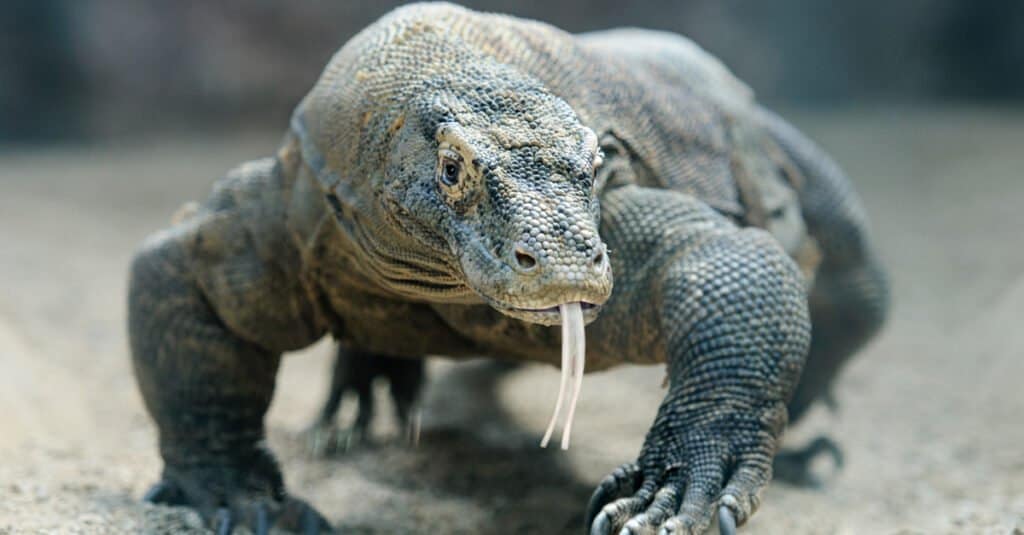
Komodo Dragon National Park was established in 1980 to protect these endangered giant monitor lizards from extinction.
©Anna Kucherova/Shutterstock.com
Apex Predators
Komodo dragons are at the top of the food chain on their native islands. These lizards can grow over ten feet long and can weigh 300 pounds or more. The Komodo dragon is the largest of the more than 3,000 living lizard species, and it has an appetite to match.
Komodo dragons are fierce apex predators who depend on prey animals much larger than themselves. These carnivorous reptiles are not picky eaters, either. They will eat the meat of virtually any animal that is available to them. Their prey of choice is Timor deer, but these lizards will also predate boar, rats, Asian palm civets, snakes, water buffalo, fish, birds, goats, chickens, and eggs. They will even cannibalize their own species. Smaller dragons may comprise up to 10% of a Komodo dragon’s diet. This is why Komodo dragon hatchlings will immediately scurry up a tree. Komodo hatchlings are excellent tree climbers, but mature adults are too heavy to climb trees.
These monitors will also scavenge carrion. Their sense of smell is so highly developed that they can detect the scent of carrion up to five miles away. Komodo dragons have even been known to dig up freshly buried human bodies and eat the remains!
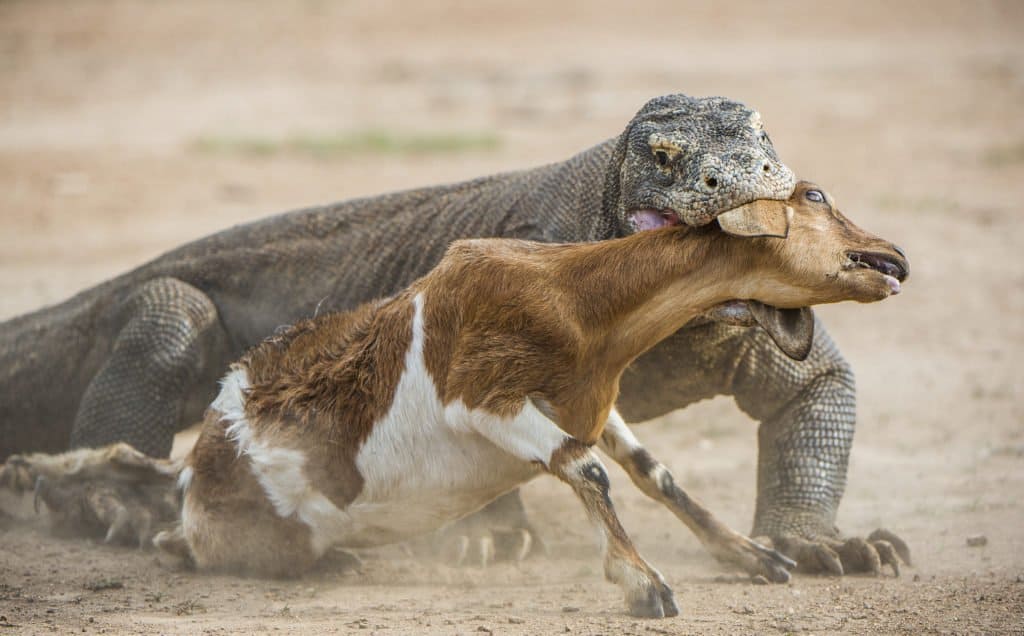
Komodo dragons are the apex predators of their small island range.
©Sergey Uryadnikov/Shutterstock.com
Dragons on the Hunt
When hunting, Komodo dragons sink their 60 large, curved, serrated teeth into their victim. If the animal escapes that initial bite, it is still almost certainly doomed. The lizard’s mouth is filled with a deadly bacteria which causes sepsis in bite victims within a matter of days. A Komodo dragon can afford to be patient as it waits for this meal. The stores of fat in its tail allow this monitor lizard to survive for more than a month without food.
Once the Komodo does have a victim on which to dine, it violently rips its prey apart, swallowing large chunks in one gulp. A dragon can eat up to 80% of its body weight in one meal!
These giant monitors live primarily in the tropical savanna forests of these few Indonesian islands, but they are also mobile predators. They can be found wandering most of the islands’ topography, from the beaches to high ridges. A Komodo dragon can cover seven miles of terrain in a day.
This massive lizard is also an adept swimmer. If the food seems to be in short supply, a Komodo dragon can swim long distances, navigating strong ocean currents to visit a different island within its range.
As apex predators, Komodo dragons are an important part of a balanced ecosystem. Whenever the population of a top predator declines, certain prey animals can overpopulate. That often leads to a decline in plants and grasses those animals need to survive. The decline of a top predator starts a destructive domino effect on the whole ecosystem.
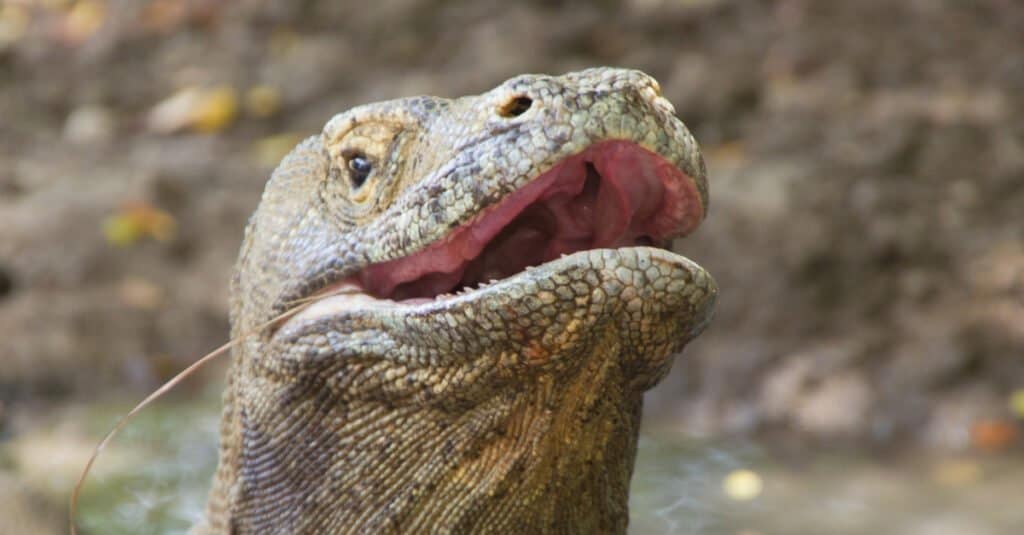
The Komodo dragon may appear toothless, but nothing could be further from the truth!
©vladivlad/Shutterstock.com
The Future of Komodo Dragons
The local Indonesian people call the Komodo dragon the ora, or the biawak raksasa, which means “giant monitor.” The Komodo dragon is an important part of the history and culture of Indonesia. The creation of Komodo National Park may very well have saved this reptile from extinction in the wild.
Still, the work must continue. The five Indonesian islands where these monitor lizards remain have a total land area roughly equivalent to the size of Rhode Island. Komodo dragons have the smallest range of any large predator in the world.
With such a small range, intense habitat management must continue if the Komodo dragon is to survive. With such a tiny area making up the entire world’s wild population of these dragons, there is little room for error in the preservation of the world’s largest lizard.

The rangers and staff of Komodo National Park will continue to be essential to the protection and proliferation of the world’s largest lizard: the Komodo dragon.
©iStock.com/ClaudineVM
The photo featured at the top of this post is © iStock.com/desertsolitaire
Thank you for reading! Have some feedback for us? Contact the AZ Animals editorial team.






